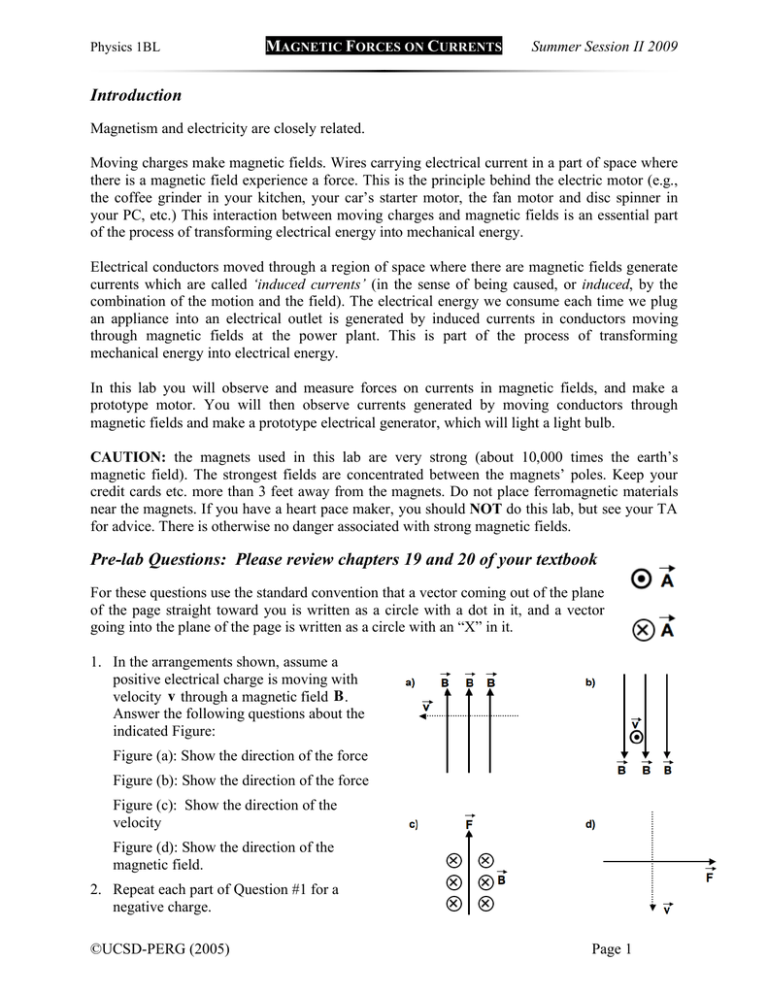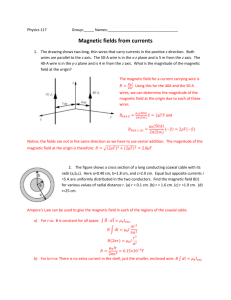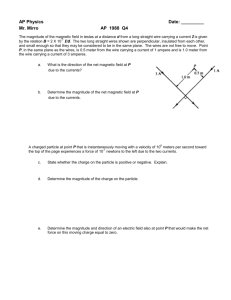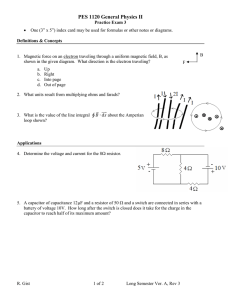Introduction M F C
advertisement

Physics 1BL MAGNETIC FORCES ON CURRENTS Summer Session II 2009 Introduction Magnetism and electricity are closely related. Moving charges make magnetic fields. Wires carrying electrical current in a part of space where there is a magnetic field experience a force. This is the principle behind the electric motor (e.g., the coffee grinder in your kitchen, your car’s starter motor, the fan motor and disc spinner in your PC, etc.) This interaction between moving charges and magnetic fields is an essential part of the process of transforming electrical energy into mechanical energy. Electrical conductors moved through a region of space where there are magnetic fields generate currents which are called ‘induced currents’ (in the sense of being caused, or induced, by the combination of the motion and the field). The electrical energy we consume each time we plug an appliance into an electrical outlet is generated by induced currents in conductors moving through magnetic fields at the power plant. This is part of the process of transforming mechanical energy into electrical energy. In this lab you will observe and measure forces on currents in magnetic fields, and make a prototype motor. You will then observe currents generated by moving conductors through magnetic fields and make a prototype electrical generator, which will light a light bulb. CAUTION: the magnets used in this lab are very strong (about 10,000 times the earth’s magnetic field). The strongest fields are concentrated between the magnets’ poles. Keep your credit cards etc. more than 3 feet away from the magnets. Do not place ferromagnetic materials near the magnets. If you have a heart pace maker, you should NOT do this lab, but see your TA for advice. There is otherwise no danger associated with strong magnetic fields. Pre-lab Questions: Please review chapters 19 and 20 of your textbook For these questions use the standard convention that a vector coming out of the plane of the page straight toward you is written as a circle with a dot in it, and a vector going into the plane of the page is written as a circle with an “X” in it. 1. In the arrangements shown, assume a positive electrical charge is moving with velocity v through a magnetic field B . Answer the following questions about the indicated Figure: !Figure (a): Show the direction ! of the force Figure (b): Show the direction of the force Figure (c): Show the direction of the velocity Figure (d): Show the direction of the magnetic field. 2. Repeat each part of Question #1 for a negative charge. ©UCSD-PERG (2005) Page 1 Physics 1BL 3. MAGNETIC FORCES ON CURRENTS Summer Session II 2009 Two current-carrying wires are exactly parallel to one another and both carry 1.5 A of current. The two wires are separated by a distance of 5.0 cm. The current in wire 1 moves down while the current in wire 2 moves up. What is the magnitude of the magnetic force caused by wire 1 on wire 2? What is the direction of the magnetic force caused by wire 1 on wire 2? 4. Write “I checked my grades online”. (Please, actually check them on webct.ucsd.edu. And if you have some problems then it would be better to solve them with your TAs during the last lab instead of emailing them during finals week.) Group Activity: A positively charged particle moves in the positive x direction in a uniform magnetic field directed into the plane of the page as shown in the diagram. The resultant force on the particle can be made zero by introducing a uniform electric field, E , of appropriate strength. What direction should the electric field point? Be prepared to explain your reasoning in detail. Experiment A: The force on a current in a magnetic field ! Review, in detail, sections 19.3 and 19.4 of your text. In this part of the lab you will gain experience about the forces that wires carrying electric currents feel when they are in a magnetic field. You will be able to measure the direction and size of those forces, and to measure the actual magnetic field strength between your magnets. A1. Disconnect the power supply from all circuits. Turn it on, and set the voltage to 2.5 V. Set the current adjusting knobs to their maximum value. (This is the same procedure as last week). Set the supply display to read current in amps. Connect the terminals of the power supply to each end of a fairly long straight wire. With the wire on the bench turn the current on and observe what happens. Can you detect any effects of the current flowing in the wire? Record the size of the current. Do not leave the current on for more than 10 seconds to avoid overheating. Next, place the wire so that it passes horizontally between the poles of the magnets. You will need to have one member of your team hold the wire so that it is a little floppy, and does not touch the magnets. You want the wire to be able to move if it experiences a force. Turn on the current and observe the wire. Does the wire deflect? Which way? Reverse the current (switch terminals of the power supply) and repeat. What happens? Are your observations consistent with the directions implied by the RH rule (i.e., current, magnetic field and force are all perpendicular to each other)? Turn the current off. Use the RH rule to label (with a piece of tape) which pole of the magnet is N. You can feel the force with your fingers. Choose the current direction that pushes the wire upwards and touch the wire lightly when the current is off. Then turn the current on, keeping your finger on the wire. You should be able to feel the wire pressing up on you. ©UCSD-PERG (2005) Page 2 Physics 1BL MAGNETIC FORCES ON CURRENTS Summer Session II 2009 If the current were exactly 2A, the magnetic field 1T, and the length of the wire exposed to the field were 5 cm, what magnetic force would the wire feel in Newtons? A2. Review the use of the force sensors: You should have a coil of 4 windings supported from a threaded rod. Connect the threaded rod supporting the coil into the tapped hole in the force sensor. Set the range to 10N, and support the force sensor in the ring stand clamp with the coil hanging down. Open the file on LoggerPro, and set the force sensor to read zero Newtons. Note that by setting F=0 when the coil is hanging from the sensor you are deliberately ignoring the weight of the coil. You are going to measure only the extra forces up or down on the coil. Start data acquisition for the force sensor, push and pull gently on the rod, record the sign of the force for upward and downward forces. A3. Measure the force on a current in a magnetic field: Connect the power supply to each end of the wire loop, and tape the wires to the ring stand. Use the power supply settings from part A1. Check that you still get about 2A in this circuit. Position the loop to hang so that only the bottom section of the loop is in the magnetic field. Note that this setup differs from your prelab question 3, as ONLY part of the bottom section of the loop is in a region where there is a B field. The sides and top are not in a magnetic field. Set zero on force sensor. You will need to do this repeatedly. The sensors tend to drift. Start LoggerPro data acquisition. After a few seconds, turn the power supply on. After a few more seconds turn it off again, then on, then off. Your graph of force vs. time should show a nice, square waveform. Be sure the measurement repeats exactly and that zero is set correctly. Always leave the current at zero between measurements. To make the best measurement from the LoggerPro data, use the “statistics tool”. Highlight a clean part of the plot where the current is ON (this should avoid spikes and jumps etc.) With the statistics tool measure the mean force for this section of your data only. Next, highlight a clean part of the graph where the current is off. Ideally, this should be zero, but the sensors can drift so you need to measure the “off force”. Your best estimate of the force caused by the interaction of the current with the magnetic field is the difference between these “on” and “off” values. Record the current, the values of the force when the current is on and off, and the calculated force difference. A4. Measure the force for different currents by changing the current adjust on the power supply. Remember to use the “set zero” for the force sensor when the current is off, just before each run. Make a table of current vs. force for currents of +2A (done above), +1A and +0.5A. Reverse the electrical connection to the power supply and complete your table for currents of approximately -2A, -1A, and -0.5A. Plot by hand in your lab book the graph of current vs. force. Is this a straight line? Do you expect it to be a straight line? What is the meaning of the slope of this line? A5. Calculate the strength of the magnetic field. Measure and record the length of the wire between the magnets. Using the best eyeball fit of a straight line to your data, what is the slope of the line? Calculate the average magnetic field along the wire. Why is making a graph a better experimental technique than a single measurement of the force on the wire at a known current? ©UCSD-PERG (2005) Page 3 Physics 1BL MAGNETIC FORCES ON CURRENTS Summer Session II 2009 A6. Record your magnetic field value on the class white board. Are all the magnets used in this lab the same strength? Do you have any evidence from your own data of spatial variations of magnetic field between the pair of magnets you used? Note: The magnetic fields for the bar magnets used last week are 10 mT (magnetic field units are Tesla, 1 mT is 10-3 T) and the magnetic field of the earth is around 10-4 T. Fields made by electromagnets can be as large as a few T and the max fields made by humans in particle accelerators are 45 T for a continuous field and 800T for a pulsed field. (Continuous means on all the time, pulsed means on for only short bursts). If you have an MRI you are exposed to between 0.5 and 2.0 T. Prior to an MRI a patient is scanned for metal objects. People with heart pace makers or aneurysm clips cannot have an MRI for safety reasons. The force an electric current experiences in a magnetic field is the basis for the operation of electric motors. Motors are useful as they transform electrical energy, which is easily transported through wires, to mechanical energy which is highly desirable and not easily transportable. The coil you used in this lab would not be very efficient in a practical application as the wire experiences a force that would move it out of the electric field. Section 19.5 in your textbook describes some ways that are used to overcome this problem in actual motor designs. Experiment B: Currents and EMFs from moving conductors in magnetic fields Review sections 19.6 and 20.1 through 20.5 before doing this lab. In this section you will be using your own mechanical energy (deriving from the Wheaties you had for breakfast) to move a wire, or loop of wire through a region of space where a magnetic field exists and to generate electrical energy in the circuit. Moving a wire through a stationary magnetic field is essentially the same as leaving the wire fixed and moving the magnetic field: It is the relative motion that is important. Changing the magnetic field strength (or magnetic flux) through a coil produces a force on the charges in the wires. This makes an electrical current and an electromotive force (EMF). You will be able to see what happens as you move loops of wire in to and out of the field between the magnets. B1. Use the coil from experiment A: Turn off the power supply and disconnect it from the coil. Remove the force sensor from the clamp support and carefully unscrew the threaded rod from the force sensor. The threaded rod now acts as a handle. Connect the LabPro ammeter across the coil. Be sure that your LoggerPro window can record current. Look carefully at how the coil is wound. Choose a direction (either way is OK) and put a label with an arrow for current direction on the bottom section of the coil. Follow the chosen current direction and adjust the ammeter connections so that it will register positive current when current is in the direction you labeled. (The ammeter registers positive current when the current enters its red terminal and exits through its black terminal). Put the coil between the magnets as for Experiment A. The bottom part of the loop should be between the magnets. Start LoggerPro, and with a small jerk move the coil UPWARDS so the bottom part is clear of the magnetic field. Record the size and sign of the current. Record the exact geometry – i.e., the direction of the magnetic field, the direction of the current, and the direction of motion. ©UCSD-PERG (2005) Page 4 Physics 1BL MAGNETIC FORCES ON CURRENTS Summer Session II 2009 Repeat a few times (ALWAYS MOVING UPWARDS). Note the difference between moving fast and moving slowly. What do you think is happening to the charges in the wire? Explain your reasoning. PREDICT what will happen to the current if you move the bottom part of the coil DOWNWARDS starting outside the magnetic field and finishing between the magnets. Perform this experiment and record your observations next to your predictions. Be careful not to damage the coil by crashing it into the bottom spacer as you insert it between the magnets. Record directions of the magnetic field, the motion and the current. Examine the current induced by both the upwards motion and the downwards motion to see if it is consistent with the right hand rule. Note what part of the right hand you use to represent each vector. Can you make a current by moving the coil SIDEWAYS? B2. Generate enough power to turn on a light emitting diode (LED) with a pre-wound coil. Large numbers of turns of fine wire are used in motors to increase the forces, and in generators to increase the EMFs and currents. • Your TA will provide you with a pre-wound coil. Inspect the coil to make sure it does not have any broken wires. Kinks and knots in the windings lead to broken wires and should be avoided. • Measure the resistance of your coil. It should be around 40 ohms. If the resistance is infinite (open circuit) you and your TA need to find and fix the break in the wire or start over by making a new coil. • Watch the current in the coil as you move it in and out of the magnetic field. For the same speed of motion (approximately) is this current larger than what you measured in B1? If this is so, explain. • What would happen if you repeated this experiment with a coil that only had one turn? • Remove the ammeter and attach the light emitting diode to the coil. The LED lights only when the emf exceeds 1.5V. Can you get the LED to light? Does it stay on continuously? Explain why or why not? Where does the light energy come from? ©UCSD-PERG (2005) Page 5





